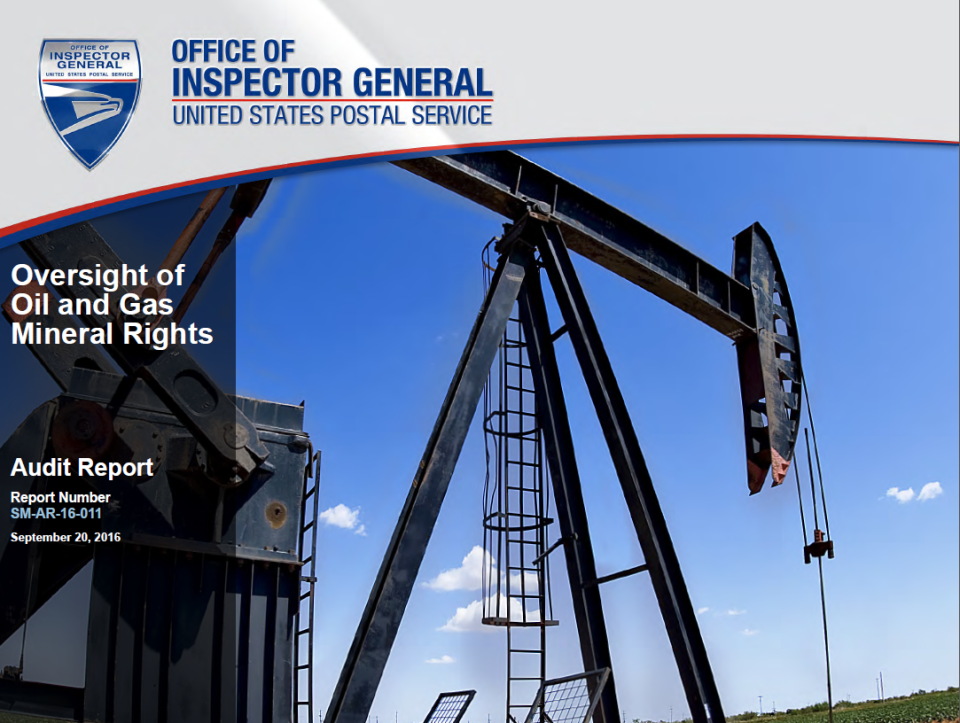Oversight of Oil and Gas Mineral Rights
Background
Mineral rights are the rights to resources that exist beneath the surface of a property, including oil and gas, ores and metals, or other raw materials. In some states, the surface of a property or land rights can be owned separately from the minerals underneath the land. Many mineral rights owners allow companies to explore, drill, extract, and dispose of minerals on their property or land in return for royalty income. Before conducting any surface-disturbing activities, such as drilling, a company must determine mineral rights ownership, obtain approval from the owners, and initiate a lease agreement.
The U.S. Department of the Interior (DOI) administers the mineral leasing program for about 245 million surface acres of federal land and 700 million sub-surface acres of mineral estate; and collects royalty payments, rent, bonuses, penalties, and other revenue for the program from over 2,900 organizations. In fiscal year (FY) 2015, the DOI managed 44,213 mineral leases and received over $5 billion in oil royalties and over $1.3 billion in gas royalties.
Federal law gives the DOI authority over mineral leases on federal lands and its entitlement to royalties; however, these laws do not apply to the U.S. Postal Service, which owns about 8,300 properties consisting of 20,805 acres of land.
During FY 2015, the Postal Service managed 32 properties with oil and gas leases and received royalty payments totaling $101,700. Facilities is responsible for managing the Postal Service’s oil and gas leases, including collecting, tracking, and validating royalty payments.
Our objective was to assess the Postal Service’s oversight of oil and gas mineral rights.
What the OIG Found
The Postal Service needs to improve its oversight of oil and gas mineral rights. Specifically, the Postal Service did not know which of its properties had oil and gas mineral rights and had no mechanism for tracking or maintaining properties with mineral rights. In addition, the Postal Service needs to improve its management of oil and gas leases and its collection, tracking, and validation of royalty payments. Further, the Postal Service did not retain mineral rights ownership or consider the value of mineral rights when selling or acquiring properties.
Based on our review of oil and gas lease documentation, we found that:
- Facilities could not provide copies of leases for five properties and was unable to determine whether four of the five properties had leases in place. It also had no established lease for one property, even though the Postal Service received royalty payments valued at $14,108 for this property in FY 2015.
- Nineteen leases were not signed by one or both parties.
- Nine leases had a different lessee listed than the one in Postal Service records.
- Two leases Facilities claimed were inactive were still active. Based on our work, the Postal Service has collected $13,244 in royalty payments due since May 2013 for one of these properties and recovered a one-time lease payment in the amount of $34,343 for the other property.
Based on our review of royalty payments, we found that Facilities:
- Incorrectly recorded royalty payments of $87,592 instead of $101,700 for FY 2015.
- Did not record four royalty payment checks valued at $7,847.
- Did not validate the accuracy of royalty payments received.
These conditions occurred because the Postal Service considers the oil and gas mineral rights effort a passive revenue program and management stated they do not have the resources to identify properties with mineral rights and rely on oil and gas companies to notify them. Management also does not have a written policy for managing oil and gas leases and collecting, tracking and validating royalty payments. In addition, management stated it does not retain or consider the value of mineral rights when acquiring or disposing of properties because it is not a part of the Postal Service’s mission.
If the Postal Service does not properly manage its properties with mineral rights and does not properly collect, track, and validate royalty payments, it might not receive all entitled royalty revenue. In addition, not retaining mineral rights ownership or considering the value when acquiring or selling properties may result in the Postal Service not achieving the best price and losing potential revenue.
The DOI, through its examinations and data mining efforts, verifies data accuracy by evaluating information submitted by oil and gas companies and completes compliance reviews every 3 years to determine the reasonableness of reported revenue by oil and gas companies. By working with the DOI to identify best practices for collecting, tracking, and validating royalty payments, the Postal Service could ensure oil and gas companies are complying with lease terms and royalty payments are accurately reported and paid.
What the OIG Recommended
We recommended management develop a process to identify and track owned properties with mineral rights and determine if the Postal Service is entitled to royalty payments; and develop a policy outlining its responsibilities for overseeing mineral rights, reviewing and updating all oil and gas leases, and collaborating with the DOI to identify opportunities and best practices for collecting, tracking, and validating royalty payments.

